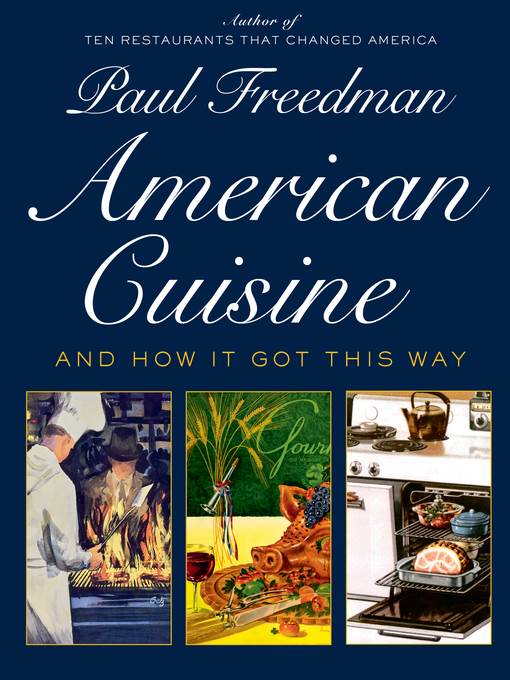
American Cuisine
And How It Got This Way
کتاب های مرتبط
- اطلاعات
- نقد و بررسی
- دیدگاه کاربران
نقد و بررسی

July 15, 2019
In this well-researched history, Freedman (Ten Restaurants That Changed America) tracks American eating habits from the colonial era to the present in search of a definitive “American cuisine.” Freedman scours decades of dining guides and community cookbooks (sharing recipes throughout) for evidence of regional traditions. He discovers that once Americans could buy “factory-made products at any market anywhere in the country, distinctions among regions and places were obliterated” and mainly lived on in cultural imagination. (Who really eats baked beans in Boston?) Freedman picks apart patterns of appropriation, starting with colonizers’ adoption of indigenous crops, from the now out-of-favor “Indian pudding” (cornmeal, eggs, raisins, butter) to the still ubiquitous pumpkin pie. He exposes the efforts of white Southerners to distance their cooking from African-American soul food in the early 20th century and examines “ethnic” cooking in a country shaped by its immigrants (while German food “was incorporated into the American repertoire, Chinese cuisine remained identifiably foreign”). He finds that, though the farm-to-table movement has revived interest in local, seasonal cooking, many Americans still turn to packaged foods that sacrifice flavor for reliability. History buffs will dig into this astute culinary narrative.

August 1, 2019
A celebration of American diversity as seen through its food. Freedman (History/Yale Univ.; Ten Restaurants That Changed America, 2016, etc.) offers a sweeping, thoroughly researched social and cultural history of America through its changing food habits and practices, from the nation's founding to the current trend of farm-to-table cuisine. Drawing on cookbooks, culinary histories, advertisements, restaurant menus and reviews, guidebooks, and chef's memoirs, the author argues convincingly that Americans do have "well-defined and consistent tastes" in food: a "national fondness for sweet, spicy, and salty combinations" and enthusiasm both for regional traditions and for variety. In examining culinary delights from different regions, Freedman points out that "invented traditions infuse regional cuisines, just about everywhere and many 'traditional' foods are not as old as most people believe." If grits and barbecue are unknown in some parts of the South, still, roadside restaurants and cookbooks long have featured dishes--stewed clams from North Carolina and cranberry chiffon pie from Georgia, for example--that evoke particular areas. Variety, though, has been compromised by the rise of agribusiness and supermarkets. Freedman notes that in 1905, 14,000 varieties of apples were grown in the U.S.; by the 1960s, only three were sold in supermarkets. By the end of World War II, processed foods came to be less expensive than fresh ingredients and tempted homemakers with more time for "work, family, and active leisure." For many decades, consumers accepted processing and lack of diversity as trade-offs for the advantages of "hygienic safety, consistency, [and] affordability." The author locates the movement against homogenization and standardization in the 1970s, which also saw a decline of French haute cuisine as the ultimate tastemaker. "All the pieces of New American cuisine--farm-to-table, seasonal, and local--were in place by the end of the 1980s," he writes. Freedman also offers entertaining profiles of many notable chefs, including Alice Waters, Thomas Keller, and René Redzepi, whose influences have reformed how many Americans eat. A spirited, abundantly illustrated food history.
COPYRIGHT(2019) Kirkus Reviews, ALL RIGHTS RESERVED.

September 1, 2019
Freedman (history, Yale Univ; Ten Restaurants That Changed America) begins this astute, well-researched exploration of American cuisine by asserting that while the United States lacks a definitive "repertoire of recognized dishes" in comparison with other nations, it does indeed exist, and should not be defined by hamburgers and hot dogs alone. Following the evolution of American cuisine from Colonial America, to the rise and decline of American regional cuisines, to the epic "golden age of food processing," Freedman provides interesting insights on the cultural impact of these shifts and the societal and historical events that preceded them. Images of menus, vintage advertisements, articles, and recipes from community cookbooks enhance the project, which includes Freeman's reflections on the current state of American cuisine and its future. He writes that while the farm-to-table movement may have gone mainstream and Americans are increasingly seeking out alternative brands with a perceived message, convenience and reliability will continue to be the key determinant for many consumers at the grocery store and at meal time. VERDICT Purchase for medium and large collections where books about food history are in demand.--Emily Patti, Fox Lake District Lib., IL
Copyright 2019 Library Journal, LLC Used with permission.

Starred review from September 15, 2019
In this significant, thoroughly researched survey of food and cooking in the U.S., historian Freedman (Ten Restaurants That Changed America, 2016) has a lot to say about who Americans have become as eaters. Reflecting on food from both nutritional and aesthetic perspectives, he proceeds from precolonial times through the twentieth century's technology and communication revolutions to today's world of both uniformity (fast food) and abundant diversity (supermarkets and ethnic restaurants). Freedman pores through regional community cookbooks across the years, analyzing just what ordinary Americans considered good eating. He describes the sociological impacts of technological changes that boosted food production and manipulated Americans with incessant, pervasive advertising. Waves of immigrants brought culinary traditions from Europe, Asia, and South America that rapidly crossed cultural boundaries to enter mainstream consciousness. If there's one takeaway from this vast, overflowing cornucopia, it's that American cuisine is not a canon but a work in progress, every day absorbing novel foods and new attitudes about what makes a good meal. Sidebars offer lists sure to provoke controversy among foodies. Both serious researchers and armchair readers will find education and amusement here. Includes many illustrations and a few recipes to support Freedman's arguments as well as a comprehensive bibliography.(Reprinted with permission of Booklist, copyright 2019, American Library Association.)

























دیدگاه کاربران